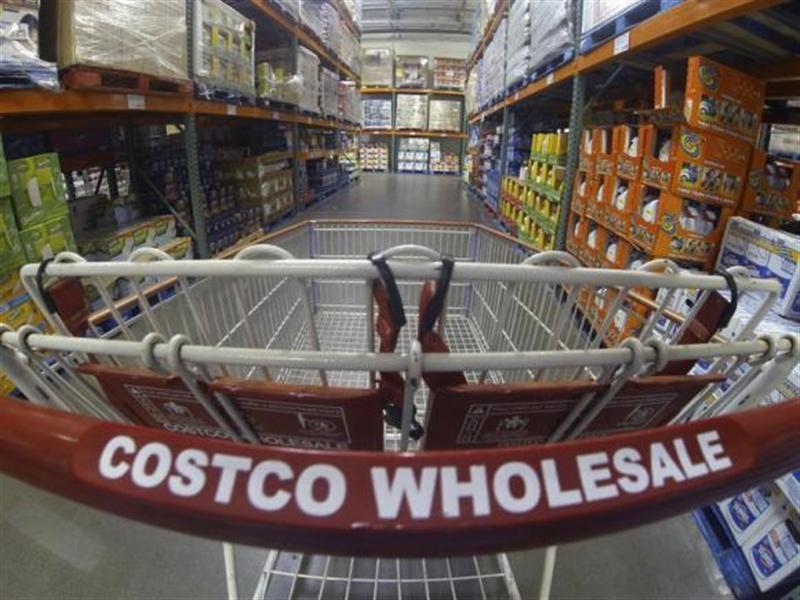April 18, 2014
NEW YORK – As superstore pricing mysteries go, it's not the equivalent of "The Da Vinci Code," but there's still something deliciously elusive about the so-called "Costco Code" that has set the tongues of shopping mavens wagging for the past several months.

April 18, 2014
NEW YORK – As superstore pricing mysteries go, it's not the equivalent of "The Da Vinci Code," but there's still something deliciously elusive about the so-called "Costco Code" that has set the tongues of shopping mavens wagging for the past several months.

A Costco shopping cart is shown at a Costco Wholesale store in Carlsbad, California September 11, 2013.
At least the plot line is direct enough: If you can interpret what the various sequences of digits and asterisks mean on Costco Wholesale Club price signs, you're on your way to scoring serious bargains.
Here's how it works, according to Costco shoppers spreading the word online: If a price at Costco ends in .99, you're paying full price. But if it ends in, say, a .97, it represents a deal with a special price decided by the manager. And if you happen to see an asterisk in the upper right corner of the sign, then the item is on its way out of the store-and probably at the lowest price you're going to see.
"That asterisk, that's the holy grail," says Kyle James, who runs the shopping blog Rather-Be-Shopping.com (http://www.rather-be-shopping.com/). He has shopped at Costco for 20 years now, and the Redding, California resident has studied the matter of the Costco Code well. By his count, he and his wife have saved at least $300 using the Costco Code over the last seven months.
For the record, he doesn't claim to have discovered it; he says there's been Internet chatter about Costco and its pricing system going back about five years before he took up the topic on his blog.
So is the Costco Code really so much of a pricing potboiler as it seems? No one would know as well as Costco's Richard Galanti, who's the company's executive vice president and chief financial officer.
Indeed he confirms that the codes do exist, though "It's more for efficiency, for the employees," Galanti says. "It's not any sort of secret agent stuff. But you see it on a blog and people think it's a secret. It's just a way of moving some merchandise, to help the fork lift operators and the stocking clerks."
Galanti says that "when a price ends in a '7,' usually it's a buyer designated markdown." And as for those asterisks, "That's what we call a pending delete. Sometimes an item's not selling well and we want to move it out, or it could be the end of the season. Let's say we've got three TV models and the latest and greatest comes out; we might want to bring the newest one in."
But Galanti cautions against reading too much into the price codes, as Costco's margins are low enough (in the 10-11 percent range) that a shopper might have more advantage buying a newer item at the ".99" full price. "The question is, do you want something at the end of its season or at the beginning of a new season?" he asks.
Retail experts say that such pricing codes and systems are common. At his website, James lists price tag codes that he's found for retailers under the juicy heading "Retailer's Big Secret: Crack the Price Tag Code."
Paula Rosenblum, managing partner of RSR Research, a retail technology research and advisory firm says Home Depot indicator is a green tag, while at Office Depot, anything with a price other than 00, 50 or 99 is a markdown.
As for why, chalk it up to something not quite as old as the human desire to crack secret codes, though it does predate computers and the digital age.
"It all goes back to the retail method of accounting, and it's a very old story," Rosenblum says. "Before the days of price scanners, and when there was no technology in the store at all, a seven at the end of a price let associates know where they were with the item. If they couldn't move it in three weeks, it was gone."
Still, she can't help throwing in an observation for consumers who choose to make note of the code, and where asterisks are most likely to appear: "Costco's non-food items don't always move fast enough, so those might be good items to add to the treasure hunt."
Much of James' information from comes from chatting up employees (many of whom have requested anonymity). At Target, for example, he says that the discounting system on clearance items, as told to him by a sales associate, goes like this: "They mark something down every 10 to 15 days. And the upper right hand corner of the clearance tag, which is red and white, has the numbers 15, 30, 50, 75 or 90 on it. And that number indicates the percentage off the original price."
Target would not confirm it uses such a mechanism. "It is not possible to determine the final markdown or timing of the price change from the item's current price," Target spokesman Evan Lapiska said.
But Lewis says his key advice for fellow shoppers on the hunt for price tag secrets is this: "Talk to the employees on the floor. I've found they're pretty open about it."
Courtesy: Reuters















































































































